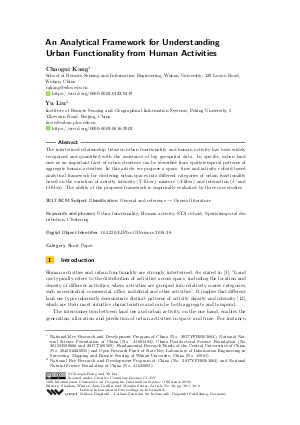An Analytical Framework for Understanding Urban Functionality from Human Activities (Short Paper)
Authors
Chaogui Kang  ,
Yu Liu
,
Yu Liu 
-
Part of:
Volume:
10th International Conference on Geographic Information Science (GIScience 2018)
Part of: Series: Leibniz International Proceedings in Informatics (LIPIcs)
Part of: Conference: International Conference on Geographic Information Science (GIScience) - License:
 Creative Commons Attribution 3.0 Unported license
Creative Commons Attribution 3.0 Unported license
- Publication Date: 2018-08-02
File

PDF
LIPIcs.GISCIENCE.2018.38.pdf
- Filesize: 0.57 MB
- 8 pages
Document Identifiers
Subject Classification
ACM Subject Classification
- General and reference → General literature
Keywords
- Urban functionality
- Human activity
- STA cuboid
- Spatiotemporal distribution
- Clustering
Metrics
- Access Statistics
-
Total Accesses (updated on a weekly basis)
0Document
0Metadata
Abstract
The intertwined relationship between urban functionality and human activity has been widely recognized and quantified with the assistance of big geospatial data. In specific, urban land uses as an important facet of urban structure can be identified from spatiotemporal patterns of aggregate human activities. In this article, we propose a space, time and activity cuboid based analytical framework for clustering urban spaces into different categories of urban functionality based on the variation of activity intensity (T-fiber), mixture (A-fiber) and interaction (I- and O-fiber). The ability of the proposed framework is empirically evaluated by three case studies.
Cite As Get BibTex
Chaogui Kang and Yu Liu. An Analytical Framework for Understanding Urban Functionality from Human Activities (Short Paper). In 10th International Conference on Geographic Information Science (GIScience 2018). Leibniz International Proceedings in Informatics (LIPIcs), Volume 114, pp. 38:1-38:8, Schloss Dagstuhl – Leibniz-Zentrum für Informatik (2018)
https://doi.org/10.4230/LIPIcs.GISCIENCE.2018.38
BibTex
@InProceedings{kang_et_al:LIPIcs.GISCIENCE.2018.38,
author = {Kang, Chaogui and Liu, Yu},
title = {{An Analytical Framework for Understanding Urban Functionality from Human Activities}},
booktitle = {10th International Conference on Geographic Information Science (GIScience 2018)},
pages = {38:1--38:8},
series = {Leibniz International Proceedings in Informatics (LIPIcs)},
ISBN = {978-3-95977-083-5},
ISSN = {1868-8969},
year = {2018},
volume = {114},
editor = {Winter, Stephan and Griffin, Amy and Sester, Monika},
publisher = {Schloss Dagstuhl -- Leibniz-Zentrum f{\"u}r Informatik},
address = {Dagstuhl, Germany},
URL = {https://drops.dagstuhl.de/entities/document/10.4230/LIPIcs.GISCIENCE.2018.38},
URN = {urn:nbn:de:0030-drops-93668},
doi = {10.4230/LIPIcs.GISCIENCE.2018.38},
annote = {Keywords: Urban functionality, Human activity, STA cuboid, Spatiotemporal distribution, Clustering}
}
Author Details
- School of Remote Sensing and Information Engineering, Wuhan University, 129 Luoyu Road, Wuhan, China
Funding
- Kang, Chaogui: National Key Research and Development Program of China (No. 2017YFB0503604), National Natural Science Foundation of China (No. 41601484), China Postdoctoral Science Foundation (No. 2015M580666 and 2017T100569), Fundamental Research Funds of the Central Universities of China (No. 2042016kf0055) and Open Research Fund of State Key Laboratory of Information Engineering in Surveying, Mapping and Remote Sensing of Wuhan University, China (No. 15S01).
- Liu, Yu: National Key Research and Development Program of China (No. 2017YFB0503604) and National Natural Science Foundation of China (No. 41625003).
References
-
Michael Batty. Urban modelling. Cambridge University Press Cambridge, 1976.

-
Luís MA Bettencourt. The origins of scaling in cities. Science, 340(6139):1438-1441, 2013.

-
Susan L Handy, Marlon G Boarnet, Reid Ewing, and Richard E Killingsworth. How the built environment affects physical activity. American Journal of Preventive Medicine, 23(2):64-73, 2002.

-
Chaogui Kang, Stanislav Sobolevsky, Yu Liu, and Carlo Ratti. Exploring human movements in singapore: a comparative analysis based on mobile phone and taxicab usages. In Proceedings of the 2nd ACM SIGKDD International Workshop on Urban Computing, pages 1-7. ACM, 2013.

-
T Warren Liao. Clustering of time series data-a survey. Pattern Recognition, 38(11):1857-1874, 2005.

-
Xi Liu, Chaogui Kang, Li Gong, and Yu Liu. Incorporating spatial interaction patterns in classifying and understanding urban land use. International Journal of Geographical Information Science, 30(2):334-350, 2016.

-
Yu Liu, Xi Liu, Song Gao, Li Gong, Chaogui Kang, Ye Zhi, Guanghua Chi, and Li Shi. Social sensing: A new approach to understanding our socioeconomic environments. Annals of the Association of American Geographers, 105(3):512-530, 2015.

-
Yu Liu, Fahui Wang, Yu Xiao, and Song Gao. Urban land uses and traffic `source-sink areas': Evidence from gps-enabled taxi data in shanghai. Landscape and Urban Planning, 106(1):73-87, 2012.

-
Gang Pan, Guande Qi, Zhaohui Wu, Daqing Zhang, and Shijian Li. Land-use classification using taxi gps traces. IEEE Transactions on Intelligent Transportation Systems, 14(1):113-123, 2013.

-
Jonathan Reades, Francesco Calabrese, and Carlo Ratti. Eigenplaces: analysing cities using the space-time structure of the mobile phone network. Environment and Planning B: Planning and Design, 36(5):824-836, 2009.

-
Jameson L Toole, Michael Ulm, Marta C González, and Dietmar Bauer. Inferring land use from mobile phone activity. In Proceedings of the 2nd ACM SIGKDD International Workshop on Urban Computing, pages 1-8. ACM, 2012.

-
Mao Ye, Krzysztof Janowicz, Christoph Mülligann, and Wang-Chien Lee. What you are is when you are: The temporal dimension of feature types in location-based social networks. In Proceedings of the 19th ACM SIGSPATIAL International Conference on Advances in Geographic Information Systems, pages 102-111, New York, NY, USA, 2011. ACM.

- Mengxue Yue, Chaogui Kang, Clio Andris, Yu Liu, Kun Qin, and Qingxiang Meng. Understanding the interplay between bus, metro and cab ridership dynamics in shenzhen, china. Transactions in GIS, 2018. URL: http://dx.doi.org/10.1111/tgis.12340.
